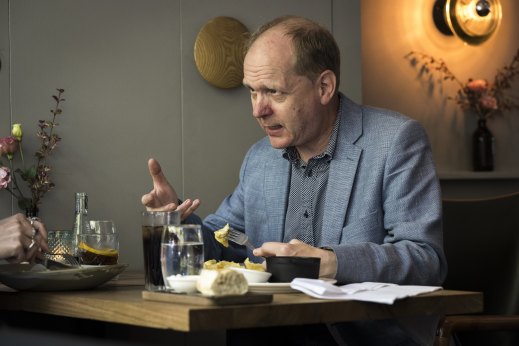Meet the shrink who spends his life inside the minds of killers

Andrew Carroll has the frank gaze and direct manner of a man used to making rapid assessments.
One of Victoria’s most respected forensic psychiatrists, Carroll has assessed countless violent crimes. Think of a high-profile killing, and there’s a good chance Carroll has been called upon to cast his professional gaze over the person accused.
Dr Andrew Carroll has met more murderers than most.Credit:Chris Hopkins
As a society, we’re drawn to and repelled by violent crimes in equal measure; seeking to understand them even as we try to convince ourselves they couldn’t happen to us.
Insofar as criminal trials help make sense of the incomprehensible, the role of a forensic psychiatrist is to help the justice system establish whether people charged with violent crimes are “mad or bad”, to borrow the hackneyed phrase.
The simplistic concept of “evil”, Carroll says, does little to explain why some people behave in this way. “Evil, I think, is probably best considered as a moral evaluative construct rather than a psychiatric construct,” he says. “But particularly for the high-profile cases, I think society legitimately expects some explanation, like: ‘Why the hell did that happen?’”
And sometimes, he says, there simply is no easy explanation.
“I think we kid ourselves if we think we’re getting at some ultimate truth. As forensic psychiatrists, our job is to provide a meaningful, logical, hopefully evidence-based, psychiatric narrative. And the cases where psychiatry plays a part, often, are the otherwise inexplicable cases.”
Unusually for a forensic psychiatrist who works within the legal system, Carroll has agreed to meet today – in his private capacity, he hastens to say, rather than as a spokesperson for the Victorian Institute of Forensic Mental Health (known as Forensicare) or any other organisation.
He has done this because he wants us to think about people caught in the justice system as being in need of rehabilitation and, often, medical care.
“Undoubtedly, punishment plays an important social role in every civilised society,” Carroll says.
“But we’ve got to move away from the notion that these people are somehow fundamentally different from us, and nothing’s ever going to help [them]. And we’ve got to move away from the notion that if we punish them harder and harder, somehow that’s going to be a solution. We’ve got 100 years of evidence now that it actually doesn’t work that way.”
Plump, cheese-filled tortelloni are nestled on a butter and sage sauce.Credit:Chris Hopkins
Today we’re meeting at Bottega in the heart of Bourke Street’s Italian precinct. Carroll orders a quattro formaggi tortelloni with butter and sage, while I opt for ricotta gnocchi with pesto, confit cherry tomatoes and generous shavings of aged Parmigiano Reggiano.
Essentially, we’ve ordered two versions of the same meal – comforting carbohydrates smothered with lashings of cheese. It is filling and homely food; the culinary version of a nonna’s hug.
Carroll returns to his theme: the expectation prisons should be punitive institutions that reform transgressors by treating them harshly.
Ricotta gnocchi at Bottega.Credit:Chris Hopkins
Carroll points to reforms within the Scandinavian prison system over the past two decades that show how our prisons could be transformed into places of reform and rehabilitation rather than punishment.
“When you actually look at the offender rehab literature and the sorts of things that work, it’s all things that are good for the person anyway,” he says.
“To give a person skills and emotional regulation; to give them meaningful occupation in the broad sense, whether that be a job or some other goal-directed activity; to give them strategies for avoiding excessive substance use; to give them a roof over their head.
“These are all things that simultaneously manage risk, if you want to put it in those terms – or enhance safety, as we prefer to say – but they also help the person to have a better life.”
In Victoria, a “tiny” number of violent offenders wind up in intensive custodial care like that provided by Forensicare’s Thomas Embling Hospital. A minority of these people will probably never be able to rehabilitate enough to reintegrate safely into society, Carroll says.
He describes an encounter that left him feeling physically ill for days, during which a male prisoner coldly described the killing of his victim with little insight and no regret. The experience was “chilling”.
“But I think the mistake is to assume that that’s the majority. The fact is, the vast majority [of prisoners] are going to come out, and so the prison role has got to be less about punishment, and much more about reform.
“There’s this assumption amongst most people that if you talk about rehabilitation support and transitional housing for offenders that you’re being soft on crime, but you’re actually advocating for things that will enhance public safety in the long run.”
At a fundamental level, Victoria’s Crimes (Mental Impairment and Unfitness to be Tried) Act holds that people can’t be held criminally responsible for their actions if their mental health condition, or cognitive impairment, leaves them unable to understand the “nature or quality” of their actions, or that their actions were wrong.
In theory, at least, if people fall into this category they will either be found unfit to stand trial, or found not guilty by way of mental impairment. Then, they will be given either a custodial or non-custodial supervision order.
In practice, however, the majority of people Carroll deals with are or will be convicted criminals in prison. Most are caught in seemingly perpetual cycles of trauma.
“There is a lot of unmet need,” he says.
“The broad swath of unmet need is around trauma-related conditions. It’s unusual to meet a male prisoner who will tell you that their childhood was all just fine. They’ve experienced neglect, absent fathers, institutional abuse, intra-familial abuse. But because of inadequate resourcing, those men will not have ready access to psychological treatments [in prison].
“And that matters for public safety. Because if we don’t optimise people’s health while they’re in prison, their mental health and the impact of any rehabilitative interventions are not going to be as strong. If we release them back out, still with the trauma-related symptoms, it’s back into that cycle of substance use and reoffending.”
While his professional gaze is focused on the Victorian system, Carroll still looks to the international experience – including his native Britain – for lessons in how we could improve rehabilitation prospects for people with complex mental health and psychosocial needs.
“Britain has four times as many forensic beds per capita as we do … and we’ve got a higher GDP per capita than England,” he says.
“So what that means in practice is that offenders with a significant mental disorder will very likely be diverted to hospital [in Britain], where they will be appropriately treated and rehabilitated from the get-go.”
The truth is, Victoria’s prisons – and prisons everywhere – are filled with people who have mental impairments and mental illnesses.
The bill, please: Lunch at Bottega is a sophisticated but comforting experience.Credit:The Age
Research cited by the NSW Law Society Journal shows that in 2022, about 98 per cent of women in Australian prisons had experienced trauma, and almost 85 per cent had been subject to violence. Up to 73 per cent of female prisoners lived with acquired brain injuries.
A forensic psychiatrist for more than 20 years, Carroll has long been drawn to the study of what makes humans tick. When he was 12, he was poking around a second-hand bookshop in Southport, north of his native Liverpool in England’s north-west, when his eye was drawn to a bound magazine collection called Know Yourself.
Inside were articles that fascinated the young Carroll, including the Milgram experiment – where participants willingly administered what they believed to be electric shocks to strangers, up to and including the use of potentially fatal shocks (the experiment was designed to prove psychologist Stanley Milgram’s hypothesis on the psychology of genocide and the willingness of people to follow orders that clashed with their consciences).
These days, Carroll’s main focus is the mental health training and consultancy group Our Curious Minds, which he established with colleague Brett Bridges with the aim of supporting frontline mental health workers in their delivery of care to clients.
He also works as a consultant for Forensicare and as the visiting psychiatrist at Hopkins Correctional Centre at Ararat.
For someone whose professional life seeks to translate the “psychiatric narrative”, as Carroll puts it, he also acknowledges that in some crimes that narrative can only take us so far.
“It’s certainly not an ultimate explanation. If you say, for example: ‘he attacked his next-door neighbour because he had a delusion his next-door neighbour was beaming X-rays into his head’ – that’s a kind of explanation. But psychiatric explanations only take you so far. And at some point, you just have to say ‘well, that’s what happened’.”
Most Viewed in National
From our partners
Source: Read Full Article



